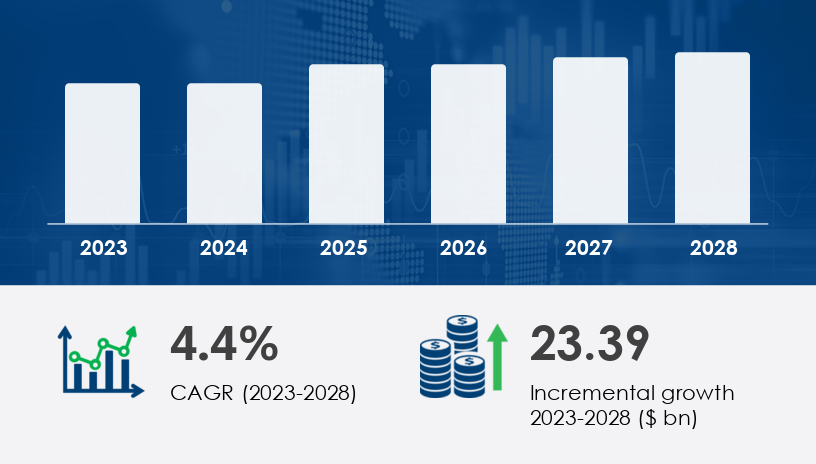The heat network market size is forecast to increase by USD 23.39 billion at a CAGR of 4.4% between 2023 and 2028. The market is witnessing significant growth due to various driving factors. Regulatory changes and government initiatives are key catalysts propelling the market's expansion. For instance, the US Energy Policy Act of 2005 encourages the development of district heating and cooling systems. Additionally, irregularities in the pricing of thermal energy networks are being addressed through the implementation of transparency regulations, such as the Heat Network (Metering and Billing) Regulations in the UK. Renewable energy sources, such as biomass and geothermal, are becoming increasingly popular for heat distribution in energy grids. However, challenges persist, including the high upfront costs of installing sustainable heating networks and the need for standardization in technology and regulations across regions. To mitigate these challenges, industry collaborations and technological advancements in heat pumps, cogeneration systems, renewable heating, and heat exchangers are essential.

For more details about the industry, get the PDF sample report for free
Hot Water Heat Network
Steam Heat Network
Residential
Commercial
Germany
UK
Sweden
Denmark
China
Japan
South Korea
US
The hot water heat network segment is estimated to witness significant growth during the forecast period. The market is expanding as cities pursue sustainable heating solutions. For instance, the city council of Plymouth, UK, is planning the initial phase of a district heating system that will distribute thermal energy from a central source to multiple consumers through underground pipes carrying heat distribution water. This system eliminates the need for gas boilers or electric heaters in each building, offering a renewable heating alternative.
Heat generation sources include power generation and waste heat, with renewable sources playing a crucial role in the energy transition and carbon emission reduction. Energy efficiency is a key factor driving market adoption, making heat networks an attractive option for both residential and commercial areas.
The European market is witnessing notable expansion due to forward-thinking initiatives and strategic partnerships. For instance, NTT's plan to link its Frankfurt data center to a local district heating system in Hattersheim am Main highlights the potential of utilizing waste heat from data centers for sustainable heating. Announced in June 2024, this collaboration with Mainova aims to heat over 600 households using thermal energy from NTT’s data center.
The NTT Data center will primarily supply heat distribution, while an existing gas-powered cogeneration system will remain for peak loads and backup. This project contributes to greenhouse gas emission reduction, improving air quality, and lowering energy grid costs for households.
Regulatory changes are a key driver in market expansion.
The market is experiencing significant growth due to a rising focus on energy efficiency, reducing greenhouse gas emissions, and improving air quality.
The adoption of renewable heating sources such as geothermal and solar thermal is increasing.
Advanced heat exchangers, sensors, and data analytics are being integrated into district heating networks to optimize thermal energy production.
Heat distribution systems such as community heating and microgrids are gaining popularity as energy-efficient solutions for residential and commercial sectors.
The UK Government’s commitment to new heat network legislation by 2025 aims to establish price protections and standardized heat grids.
Government initiatives are shaping market growth.
The UK’s Heat Network Efficiency Scheme (HNES) is driving the transition to renewable heating by providing financial support for improving heat distribution networks.
Advanced cogeneration systems, heat pumps, and smart sensors are being integrated into heat grids to enhance energy efficiency.
Heat exchangers and waste heat recovery solutions are gaining traction to improve thermal energy utilization.
Irregularities in heat pricing are a key challenge affecting market growth.
Energy efficiency remains crucial for reducing greenhouse gas emissions and improving air quality.
System configuration challenges such as open and closed-loop networks, hybrid systems, and waste heat recovery need to be addressed for better heat distribution.
The transition to renewable heating sources presents challenges related to energy density and heat network compatibility.
The heat network market is witnessing substantial growth, driven by the adoption of district heating and thermal networks to enhance energy efficiency in urban and industrial areas. The integration of heat pumps, biomass heating, and geothermal energy is advancing renewable heating solutions, reducing carbon footprints and promoting sustainable heating. Modern heat exchangers and piping systems are crucial in optimizing heat distribution, ensuring efficient transmission of thermal energy across extensive heating infrastructure. Additionally, the implementation of smart meters and energy storage solutions is enhancing heat monitoring and energy optimization, enabling real-time tracking of heat consumption. The expansion of heat pipelines and improvements in boiler systems further contribute to low-carbon heating, while thermal insulation and advanced heat transfer mechanisms improve system efficiency. Integration with energy grids allows better load balancing, while control systems ensure precise heat circulation and energy recovery, supporting the market's continued growth.
Get more details by ordering the complete report
Alfa Laval AB
BRUGG Rohrsystem AG
Danfoss AS
E.ON UK Plc
ENGIE SA
Fortum Oyj
FVB Energy Inc
Helen Ltd.
LOGSTOR Denmark Holding ApS
Ramboll Group AS
REHAU Ltd.
Rendesco Ltd
Statkraft AS
STEAG GmbH
Thermaflex
Uniper SE
Uponor Corp.
Vattenfall UK
Veolia Environnement SA
Viessmann Werke GmbH & Co. KG
In the heat network market, technological advancements in cogeneration systems and heat recovery methods are transforming combined heat and power generation, improving thermal efficiency and reducing operational costs. The use of advanced insulation materials and thermal storage solutions enhances heat management and energy conversion, minimizing heat loss and maximizing resource utilization. Efficient heat delivery is facilitated by innovative fluid systems, improving radiant heating and enabling better heat monitoring across residential, commercial, and industrial applications. Enhancements in thermal insulation and heating solutions optimize heat pipelines, ensuring seamless heat transfer with minimal energy loss. Additionally, heat circulation technologies and energy recovery strategies contribute to the transition toward renewable energy, strengthening the adoption of heating networks globally. The integration of thermal controls and energy optimization technologies continues to drive market expansion, reinforcing the role of efficient heating solutions in achieving energy security and sustainability goals
Safe and Secure SSL Encrypted